Numerical and Experimental Study of Optoelectronic Trapping on Iron-Doped Lithium Niobate Substrate
Abstract
:1. Introduction
2. Results
2.1. Photorefractive Field and DEP Force in Lithium Niobate
2.2. Numerical Analysis
3. Discussions
4. Materials and Methods
5. Conclusions
Supplementary Materials
Acknowledgments
Author Contributions
Conflicts of Interest
References
- Figeys, D.; Pinto, D. Lab-on-a-chip: A revolution in biological and medical sciences. Anal. Chem. 2000, 72, 330A–335A. [Google Scholar] [CrossRef] [PubMed]
- Grier, D.G. A revolution in optical manipulation. Nature 2003, 424, 810–816. [Google Scholar] [CrossRef] [PubMed]
- Ashkin, A.; Dziedzic, J.M.; Bjorkholm, J.E.; Chu, S. Observation of a single-beam gradient force optical trap for dielectric particles. Opt. Lett. 1986, 11, 288–290. [Google Scholar] [CrossRef] [PubMed]
- Craighead, H. Future lab-on-a-chip technologies for interrogating individual molecules. Nature 2006, 442, 387–393. [Google Scholar] [CrossRef] [PubMed]
- Liberale, C.; Cojoc, G.; Bragheri, F.; Minzioni, P.; Perozziello, G.; La Rocca, R.; Ferrara, L.; Rajamanickam, V.; Di Fabrizio, E.; Cristiani, I. Integrated microfluidic device for single-cell trapping and spectroscopy. Sci. Rep. 2013, 3. [Google Scholar] [CrossRef] [PubMed]
- Yang, T.; Paiè, P.; Nava, G.; Bragheri, F.; Vazquez, R.M.; Minzioni, P.; Veglione, M.; Di Tano, M.; Mondello, C.; Osellame, R.; et al. An integrated optofluidic device for single-cell sorting driven by mechanical properties. Lab Chip 2015, 15, 1262–1266. [Google Scholar] [CrossRef] [PubMed]
- Yang, T.; Nava, G.; Minzioni, P.; Veglione, M.; Bragheri, F.; Lelii, F.D.; Vazquez, R.M.; Osellame, R.; Cristiani, I. Investigation of temperature effect on cell mechanics by optofluidic microchips. Biomed. Opt. Express 2015, 6, 2991–2996. [Google Scholar] [CrossRef] [PubMed]
- Shenoy, A.; Rao, C.V.; Schroeder, C.M. Stokes trap for multiplexed particle manipulation and assembly using fluidics. Proc. Natl Acad. Sci. USA 2016, 113, 3976–3981. [Google Scholar] [CrossRef] [PubMed]
- Khoshmanesh, K.; Nahavandi, S.; Baratchi, S.; Mitchell, A.; Kalantar-zadeh, K. Dielectrophoretic platforms for bio-microfluidic systems. Biosens. Bioelectron. 2011, 26, 1800–1814. [Google Scholar] [CrossRef] [PubMed]
- Chiou, P.Y.; Ohta, A.T.; Wu, M.C. Massively parallel manipulation of single cells and microparticles using optical images. Nature 2005, 436, 370–372. [Google Scholar] [CrossRef] [PubMed]
- Pohl, H.A. Some effects of nonuniform fields on dielectrics. J. Appl. Phys. 1958, 29, 1182–1188. [Google Scholar] [CrossRef]
- Eggert, H.A.; Kuhnert, F.Y.; Buse, K.; Adleman, J.R.; Psaltis, D. Trapping of dielectric particles with light-induced space-charge fields. Appl. Phys. Lett. 2007, 90, 241909. [Google Scholar] [CrossRef]
- Esseling, M.; Holtmann, F.; Woerdemann, M.; Denz, C. Two-dimensional dielectrophoretic particle trapping in a hybrid crystal/PDMS-system. Opt. Express 2010, 18, 17404–17411. [Google Scholar] [CrossRef] [PubMed]
- Sturman, P.J. Photovoltaic and Photo-refractive Effects in Noncentrosymmetric Materials; CRC Press: Philadelphia, PA, USA, 1992; Volume 8. [Google Scholar]
- Volk, T.R.; Wöhlecke, M. Optical damage resistance in lithium niobate crystals. Ferroelectr. Rev. 1998, 1, 195–262. [Google Scholar]
- Razzari, L.; Minzioni, P.; Cristiani, I.; Degiorgio, V.; Kokanyan, E.P. Photorefractivity of Hafnium-doped congruent lithium–niobate crystals. Appl. Phys. Lett. 2005, 86, 131914. [Google Scholar] [CrossRef]
- Zhang, X.; Wang, J.; Tang, B.; Tan, X.; Rupp, R.A.; Pan, L.; Kong, Y.; Sun, Q.; Xu, J. Optical trapping and manipulation of metallic micro/nanoparticles via photorefractive crystals. Opt. Express 2009, 17, 9981–9988. [Google Scholar] [CrossRef] [PubMed]
- Esseling, M.; Zaltron, A.; Argiolas, N.; Nava, G.; Imbrock, J.; Cristiani, I.; Sada, C.; Denz, C. Highly reduced iron-doped lithium niobate for optoelectronic tweezers. Appl. Phys. B 2013, 113, 191–197. [Google Scholar] [CrossRef]
- Esseling, M.; Zaltron, A.; Sada, C.; Denz, C. Charge sensor and particle trap based on z-cut lithium niobate. Appl. Phys. Lett. 2013, 103, 06115. [Google Scholar] [CrossRef]
- Esseling, M.; Zaltron, A.; Horn, W.; Denz, C. Optofluidic droplet router. Laser Photon. Rev. 2015, 9, 98–104. [Google Scholar] [CrossRef]
- Zaltron, A.; Bazzan, M.; Argiolas, N.; Ciampolillo, M.V.; Sada, C. Depth-resolved photorefractive characterization of lithium niobate doped with iron by thermal diffusion. Appl. Phys. B 2012, 108, 657–663. [Google Scholar] [CrossRef]
- Peithmann, K.; Wiebrock, A.; Buse, K. Photorefractive properties of highly-doped lithium niobate crystals in the visible and near-infrared. Appl. Phys. B 1999, 68, 777–784. [Google Scholar] [CrossRef]
- Volk, T.; Wöhlecke, M. Lithium Niobate: Defects, Photorefraction and Ferroelectric Switching; Springer Science & Business Media: Berlin, Germany, 2008; Volume 115. [Google Scholar]
- Villarroel, J.; Burgos, H.; García-Cabañes, Á.; Carrascosa, M.; Blázquez-Castro, A.; Agulló-López, F. Photovoltaic versus optical tweezers. Opt. Express 2011, 19, 24320–24330. [Google Scholar] [CrossRef] [PubMed]
- Arregui, C.; Ramiro, J.B.; Alcázar, Á.; Méndez, Á.; Burgos, H.; García-Cabañes, Á.; Carrascosa, M. Optoelectronic tweezers under arbitrary illumination patterns: Theoretical simulations and comparison to experiment. Opt. Express 2014, 22, 29099–29110. [Google Scholar] [CrossRef] [PubMed]
- Miccio, L.; Memmolo, P.; Grilli, S.; Ferraro, P. All-optical microfluidic chips for reconfigurable dielectrophoretic trapping through SLM light induced patterning. Lab Chip 2012, 12, 4449–4454. [Google Scholar] [CrossRef] [PubMed]
- Muñoz-Martínez, J.F.; Jubera, M.; Matarrubia, J.; García-Cabañes, A.; Agulló-López, F.; Carrascosa, M. Diffractive optical devices produced by light-assisted trapping of nanoparticles. Opt. Lett. 2016, 41, 432–435. [Google Scholar]
- Carrascosa, M.; García-Cabañes, A.; Jubera, M.; Ramiro, J.B.; Agulló-López, F. LiNbO3: A photovoltaic substrate for massive parallel manipulation and patterning of nano-objects. Appl. Phys. Rev. 2015, 2, 040605. [Google Scholar] [CrossRef]
- Ferraro, P.; Grilli, S.; Miccio, L.; Vespini, V. Wettability patterning of lithium niobate substrate by modulating pyroelectric effect to form microarray of sessile droplets. Appl. Phys. Lett. 2008, 92, 213107. [Google Scholar] [CrossRef]
- Ferraro, P.; Coppola, S.; Grilli, S.; Paturzo, M.; Vespini, V. Dispensing nano-pico droplets and liquid patterning by pyroelectrodynamic shooting. Nat. Nanotechnol. 2010, 5, 429–435. [Google Scholar] [CrossRef] [PubMed]
- Jones, T.B. Electromechanics of Particles; Cambridge University Press: Cambridge, UK, 1995. [Google Scholar]
- Kukhtarev, N.V.; Markov, V.B.; Odulov, S.G.; Soskin, M.S.; Vinetskii, V.L. Holographic storage in electrooptic crystals. I. Steady state. Ferroelectrics 1978, 22, 949–960. [Google Scholar] [CrossRef]
- DelRe, E.; Ciattoni, A.; Crosignani, B.; Tamburrini, M. Approach to space-charge field description in photorefractive crystals. J. Opt. Soc. Am. B 1998, 15, 1469–1475. [Google Scholar] [CrossRef]
- Crognale, C.; Rosa, L. Vector analysis of the space-charge field in nonconventionally biased photorefractive crystals. J. Lightwave Technol. 2005, 23, 2175–2185. [Google Scholar] [CrossRef]
- Günter, P.; Huignard, J.-P. Photorefractive Materials and Their Applications; Günter, P., Huignard, J.-P., Eds.; Springer: Berlin, Germany, 1989; Volume 2. [Google Scholar]
- Khan, F.L.A.; Sivagurunathan, P.; Kamil, S.R.M.; Mehrotra, S.C. Dielectric studies of methyl methacrylate and butyl methacrylate with primary alcohols using time domain reflectometry. Indian J. Pure Appl. Phys. 2007, 45, 754. [Google Scholar]
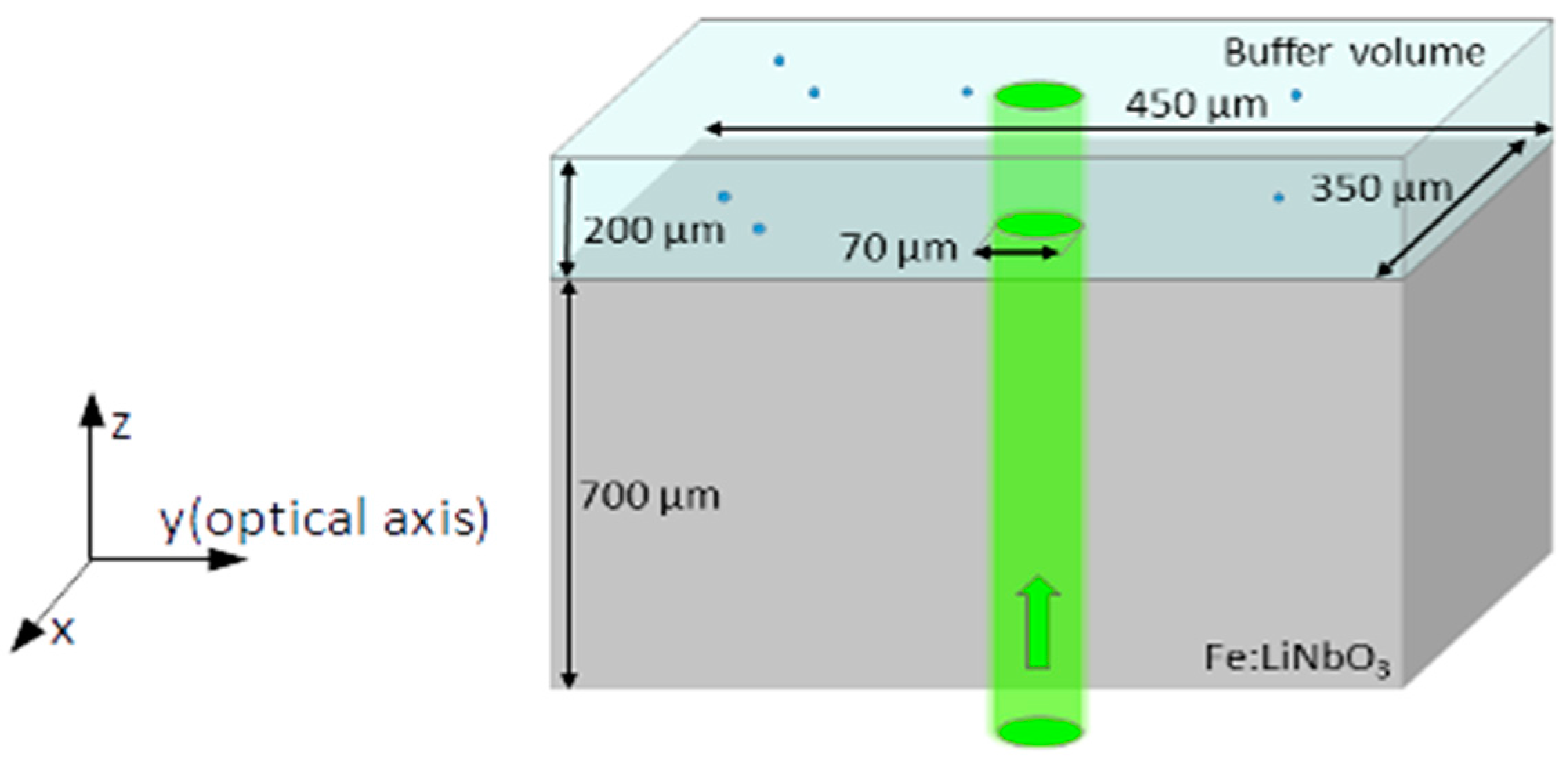

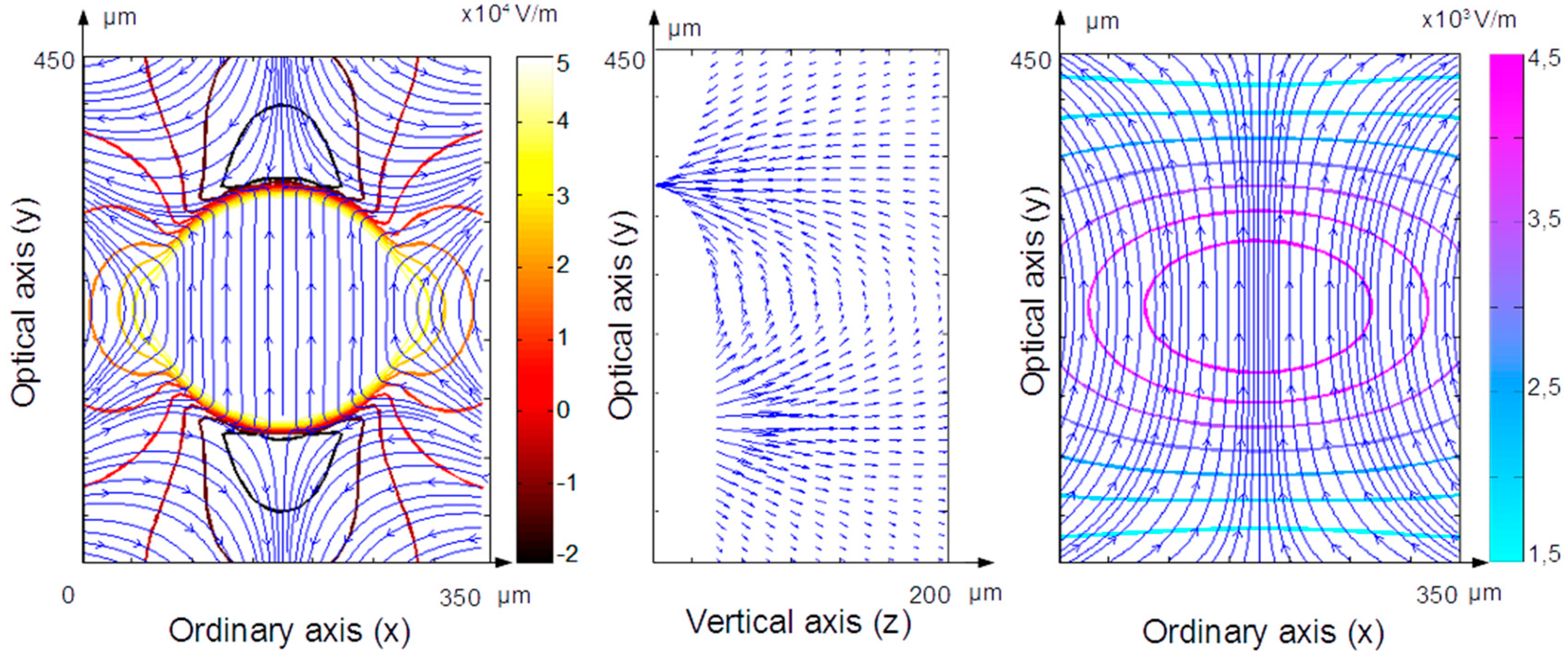
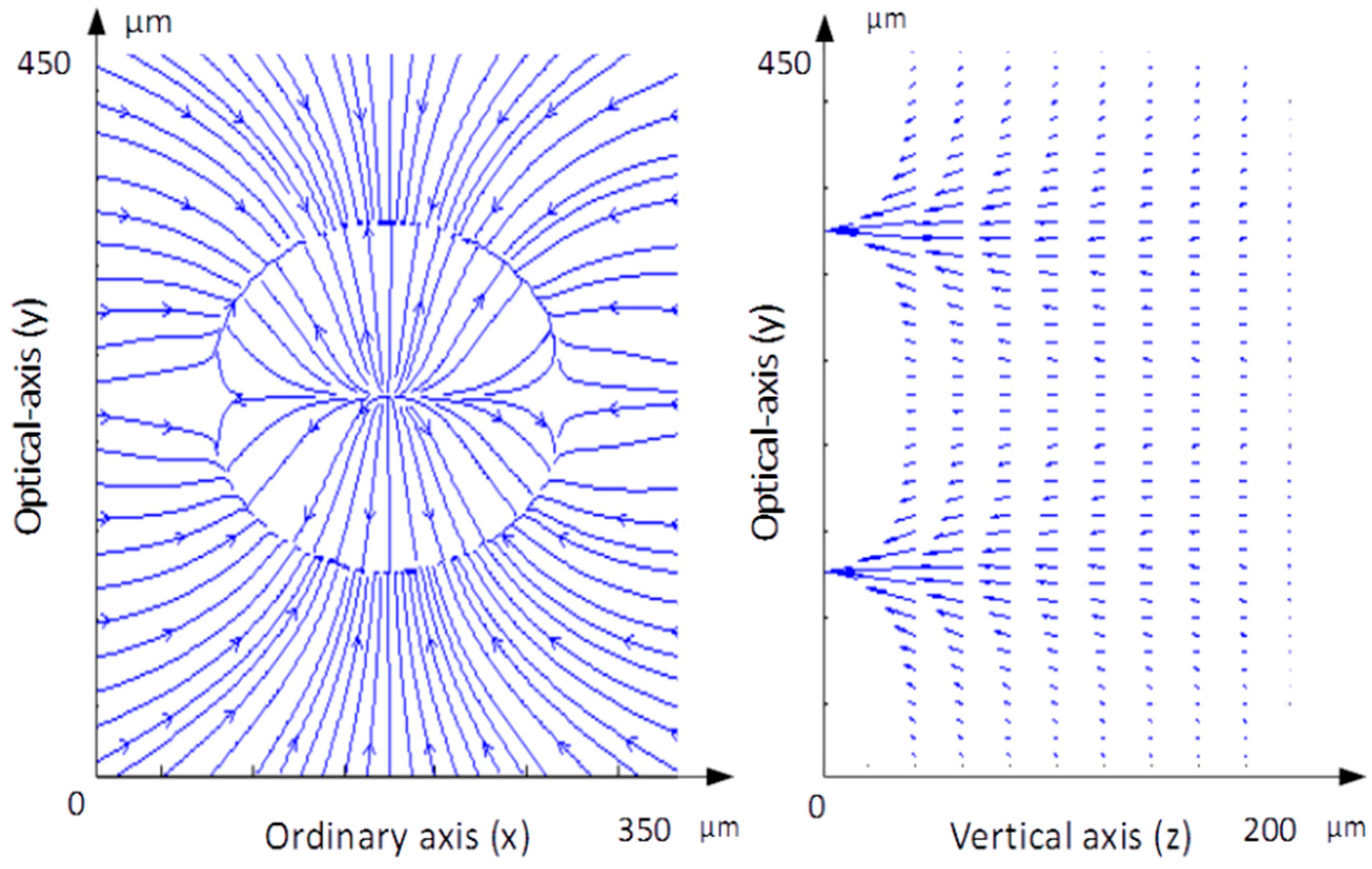
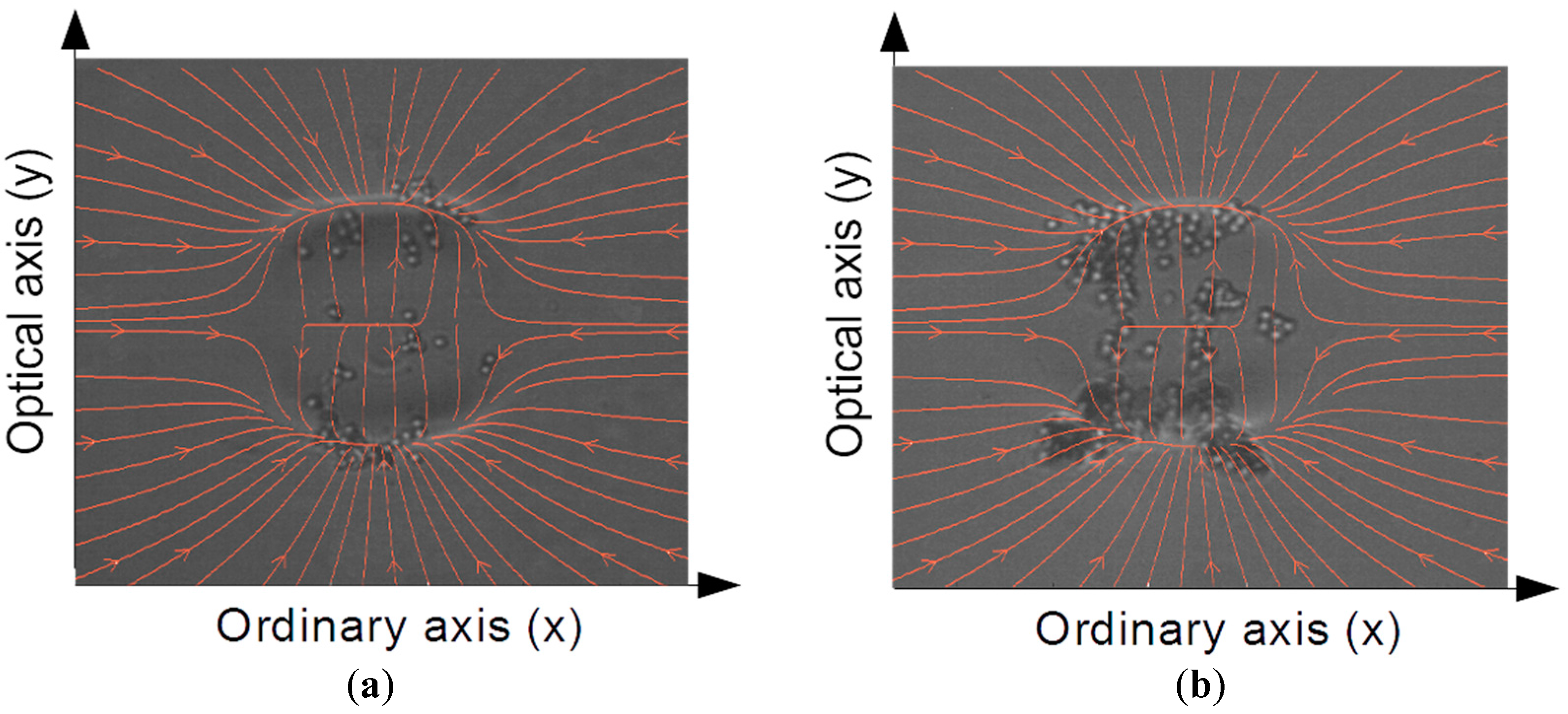

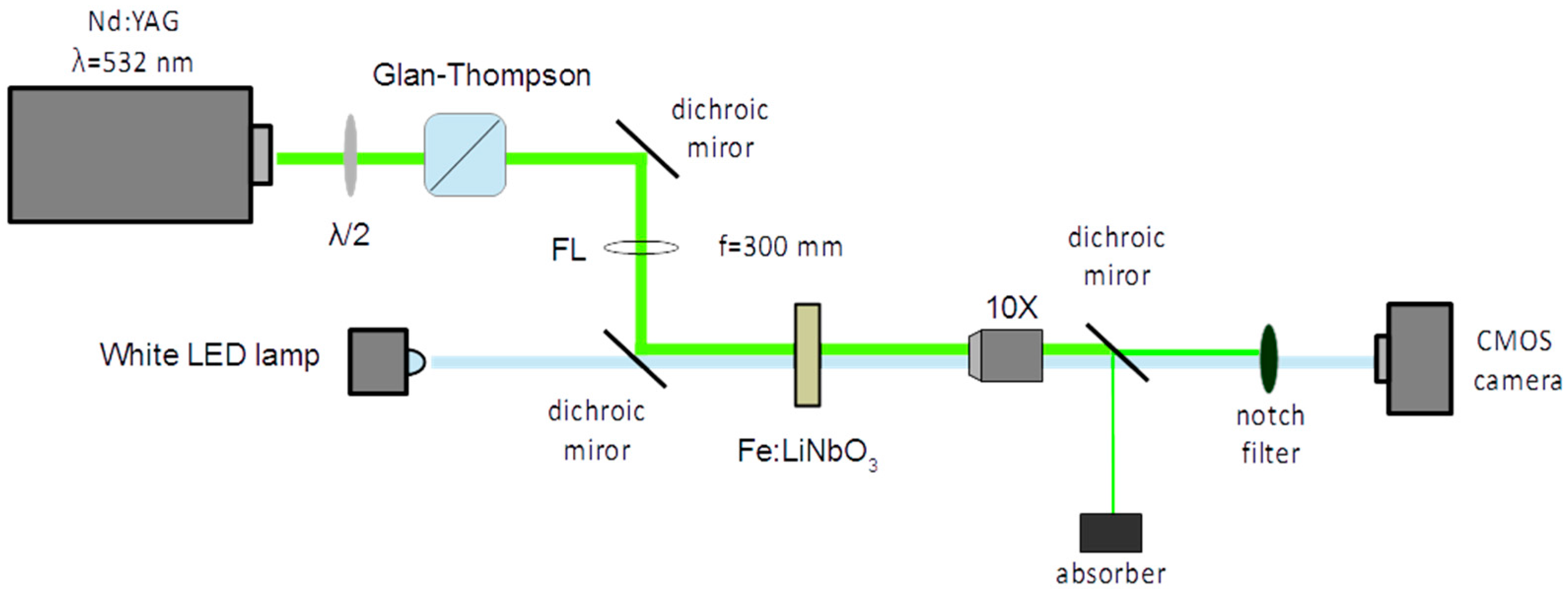
© 2016 by the authors; licensee MDPI, Basel, Switzerland. This article is an open access article distributed under the terms and conditions of the Creative Commons Attribution (CC-BY) license (http://creativecommons.org/licenses/by/4.0/).
Share and Cite
Gazzetto, M.; Nava, G.; Zaltron, A.; Cristiani, I.; Sada, C.; Minzioni, P. Numerical and Experimental Study of Optoelectronic Trapping on Iron-Doped Lithium Niobate Substrate. Crystals 2016, 6, 123. https://doi.org/10.3390/cryst6100123
Gazzetto M, Nava G, Zaltron A, Cristiani I, Sada C, Minzioni P. Numerical and Experimental Study of Optoelectronic Trapping on Iron-Doped Lithium Niobate Substrate. Crystals. 2016; 6(10):123. https://doi.org/10.3390/cryst6100123
Chicago/Turabian StyleGazzetto, Michela, Giovanni Nava, Annamaria Zaltron, Ilaria Cristiani, Cinzia Sada, and Paolo Minzioni. 2016. "Numerical and Experimental Study of Optoelectronic Trapping on Iron-Doped Lithium Niobate Substrate" Crystals 6, no. 10: 123. https://doi.org/10.3390/cryst6100123






